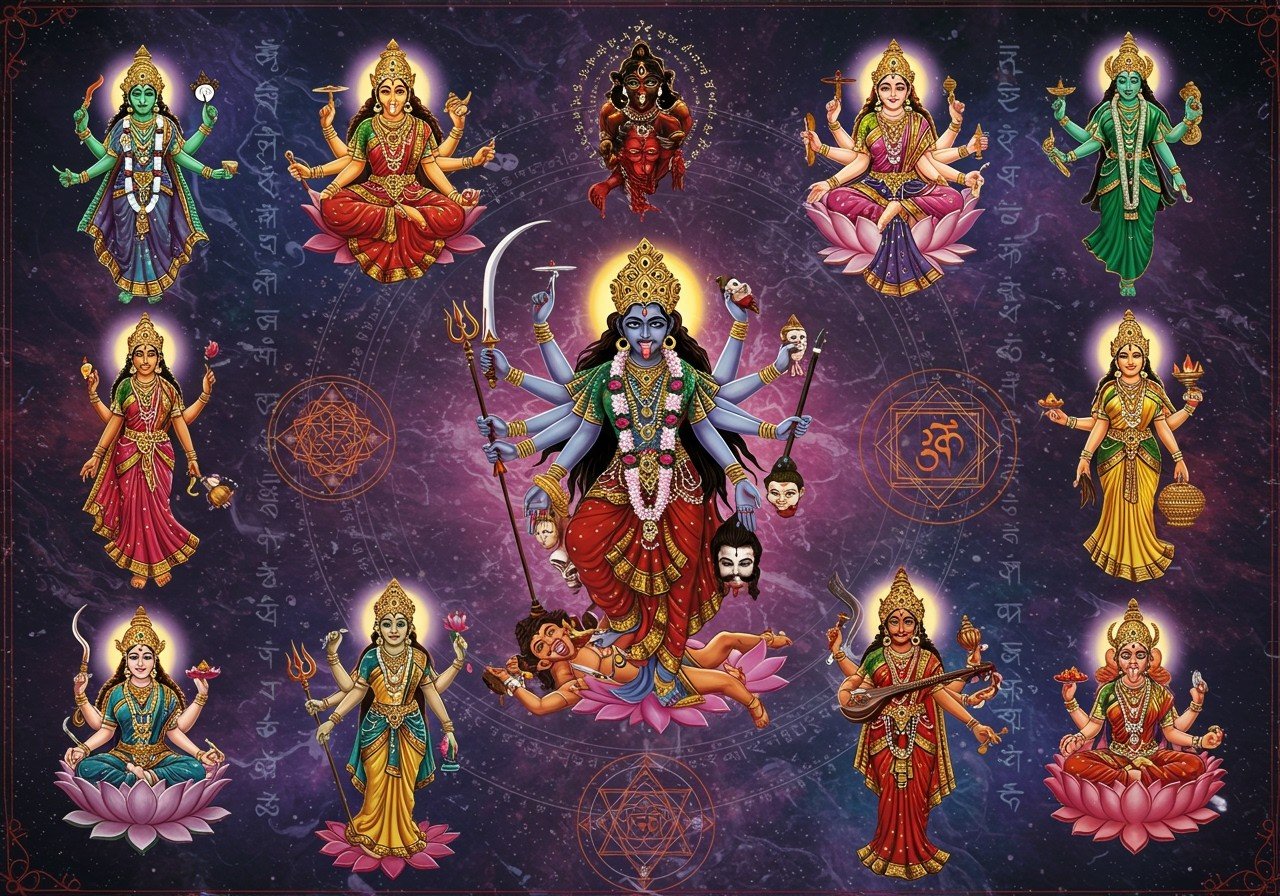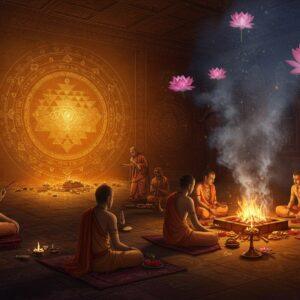
Mahavidya Sadhana is a profound spiritual practice deeply rooted in Hindu traditions. It offers a path to self-realization by exploring the worship of ten wisdom goddesses, the Mahavidyas, who embody different facets of the Divine Mother. This practice resonates deeply with those seeking authentic spiritual experiences within the rich tapestry of Indian culture. This guide delves into the significance of Mahavidya Sadhana and offers practical guidance for beginners.
Understanding the Mahavidyas
The Mahavidyas, also known as the Dasha Mahavidyas, are ten Wisdom Goddesses. “Maha” means “great,” and “Vidya” means “wisdom, knowledge, manifestation, or revelation.” They are revered in Shaktism and Tantra traditions. Each Mahavidya embodies a unique cosmic power, symbolizing a distinct facet of the divine feminine. These goddesses, including Kali, Tara, Tripura Sundari (also known as Shodashi or Lalita), Bhuvaneshwari, Bhairavi, Chhinnamasta, Dhumavati, Bagalamukhi, Matangi, and Kamalatmika (Kamala), represent a spectrum of feminine divinity, from fierce to gentle. Their worship involves practices, mantras, meditations, and rituals to connect with their energies and promote healing, transformation, and spiritual growth. They aren’t merely deities; they represent cosmic forces governing existence, consciousness, and spiritual transformation.
Approaching the Mahavidyas as a Beginner
Embarking on the path of Mahavidya Sadhana requires respect, understanding, and proper guidance. It’s recommended to seek the guidance of a qualified guru for initiation, instruction, and protection. Starting with Sri Vidya, associated with Tripura Sundari, is often advised due to its gentle nature. Prioritize simpler forms of deities initially, especially the benevolent ones. The true essence of Mahavidya worship lies in imbibing the goddesses’ qualities for spiritual transformation, not just offering praises. Cultivating a balanced approach by embracing all aspects of divine feminine energy—compassion, fierceness, wisdom—fosters harmony and transformation.
Poojn.in offers a wide selection of spiritual products, including Tulsi malas and Bel malas, to support your spiritual journey and enhance your connection with the divine. Explore our collection to find the perfect tools for your practice.
Delving into Specific Mahavidyas
- Kali: The fierce goddess of time, change, and destruction. She destroys ignorance, paving the way for spiritual growth. Her imagery is often intense, reflecting her power to overcome negativity. Deep understanding of her symbolism is key to connecting with her transformative energy.
- Tara: The compassionate savior goddess who guides devotees across delusion. She embodies swift action and protection from spiritual pitfalls. Tara is revered for her ability to help overcome obstacles. Engaging with Tara’s energy can provide strength and solace during challenging times. Explore our brass Maa Tara Murti collection.
- Tripura Sundari: The goddess of beauty, love, and desire. She represents the union of spirit and matter. Her worship focuses on cultivating inner beauty and harmony. Understanding her symbolism reveals the interplay of divine energies within the material world.
- Bhuvaneshwari: The Queen of the Universe and the embodiment of space. She represents the boundless expanse of creation. Her worship involves connecting with the vastness of existence. Contemplating Bhuvaneshwari helps understand our place within the cosmos.
- Chinnamasta: The goddess representing transformation through self-sacrifice. Her imagery can be challenging, symbolizing the surrender of ego. Understanding her profound symbolism reveals deeper layers of spiritual transformation. Learn more about sacred Hindu Symbols.
- Dhumavati: The widow goddess associated with inauspicious things, detachment, renunciation, and spiritual liberation. She teaches about impermanence and acceptance of life’s challenges. Her worship focuses on finding strength in adversity.
- Bagalamukhi: The goddess of protection who neutralizes enemies and obstacles. She represents the power to overcome negativity and conflict. Her energy is invoked for protection and resolving disputes.
- Matangi: The Tantric form of Saraswati, the goddess of knowledge and arts. She represents mastery over speech and expression. Her worship involves cultivating creative expression and communication skills.
- Kamala: The Tantric form of Lakshmi, the goddess of wealth and abundance. She represents prosperity and material well-being. Her worship focuses on attracting abundance and cultivating generosity. Explore DIY puja guides.
Essential Precautions for Mahavidya Sadhana
- Proper Guidance is Paramount: The intense nature of some Mahavidyas necessitates guidance and initiation from a qualified guru. This safeguards practitioners from potential pitfalls. Self-practice without proper understanding can be detrimental.
- Mental and Emotional Stability: Individuals with mental health challenges should exercise caution and consult a professional before engaging with these practices. The intensity of these energies can be overwhelming for those with emotional vulnerabilities. Prioritizing mental well-being is crucial.
- Respectful Approach: Approaching the Mahavidyas isn’t about picking a deity based on personal preference. It requires serious commitment, understanding, and reverence for their power. Each Mahavidya embodies specific energies, demanding specific approaches.
By understanding the fundamental principles, seeking appropriate guidance, and approaching the Mahavidyas with respect and a genuine desire for spiritual growth, beginners can unlock the transformative potential of these powerful goddesses. This journey is a deeply personal one, requiring patience, dedication, and a sincere yearning for self-realization. Learn more about meditation and mantras for inner peace.


